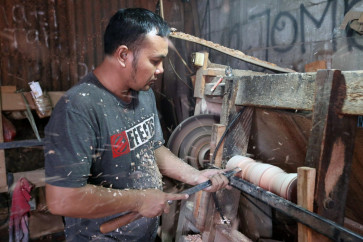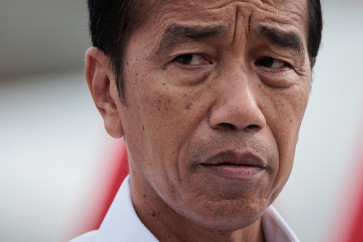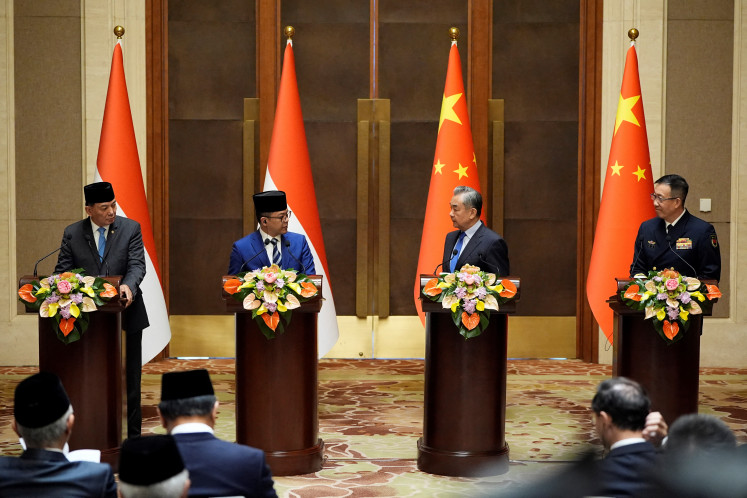The Owl Project
Rat hunter: This juvenile Titi Alba owl could help to drastically reduce rats in the rice fields of Bunutan on the outskirts of Ubud
Change text size
Gift Premium Articles
to Anyone

Rat hunter: This juvenile Titi Alba owl could help to drastically reduce rats in the rice fields of Bunutan on the outskirts of Ubud.
Perched atop a crumbling ruin on the edge of Bunutan's rice fields, a Titi Alba owl is attempting to drag a guinea pig into its manmade nesting box.
The animal, which looks more like a winged pussy cat than an efficient bird of prey, could prove to be another tool in the fight to save Balinese agriculture, according to director of permaculture with the Sawah Bali foundation, I Made Chakra. Sawah Bali is a foundation seeking to help farmers stay on their land through promoting economically viable farming practices.
Farmers in Gianyar and other parts of Bali are in a crisis. The cost of seed and fertilizers needed to grow standard hybrid rice is leaving them on the verge of bankruptcy at every harvest, and when crops fail due to weather or are lost to pests such as rats, they find themselves deeper and deeper in the depths of economic uncertainty.
With local farmers, on average, earning less than US$2 a day from their farms, Chakra says that much needs to be done to turn around and improve this dire situation. He argues that reducing a farmer's outgoings and yield loss is a key factor in this reversal.
It is hoped that the owl project can reduce rat populations in rice fields because it is believed that a pair of Titi Alba owls can hunt down more than 800 rats every month over a 4 hectare territory.
'First we had to diagnose the problem. There is no money in farming. In Gianyar, a farmer working the average 3,000 square meters of farmland, and working it full time, will only earn Rp 23,800 [US$1.80] per day,' says Chakra at a model farm in Bunutan, on the outskirts of Ubud. The farm at Bunutan applies the science of sustainable farming by reducing crop outlays to almost zero.

The meager incomes of farmers were revealed to Chakra during farmer meetings where incomes from yields were measured against outgoings.
'The 23,800 figure was reached when I was workshopping with farmers. On a board they wrote for me how much income was spent on seed, fertilizers and chemicals, all the unhealthy stuff you can think of, and the net figure comes down to 23,800 based on outgoings and yield. The farmers were shocked to see how little they were earning,' said Chakra, adding that until that time there had never been a systematic evaluation of farmer's net incomes.
Sustainable farming is based on the low external input model that reduces outgoing costs, leaving far more of the yield to return to the pockets of farmers. By using owls to reduce pests, rotating crops with legumes and using natural fertilizers and local rice strains, Chakra and Sawah Bali believe that farming in Bali can become sustainable.
'[Outlay reductions] start with Heritage Rice, which is rice that you can grow and keep using by recycling the seed from a previous yield to grow the next crop,' said Chakra, pointing out that hybrid rice strains are essentially sterile and do not reproduce, forcing farmers to buy seed every planting season.
While going organic with local rice species can improve income and cut expenses for farmers, it is not enough to guarantee improved incomes and sustainable farming. The damage wrought on crops by rats can still be devastating. According to Chakra, rats wiped out 80 percent of the rice crops in Taro recently.

'Before chemical farming, our rice fields had natural predators to contain rats. There was the alutan, or rat snakes, that naturally controlled the rat population. With the disappearance of snakes due to chemical poisoning from eating rats that have foraged on the rice, the rat problem has become severe. To solve it, we've come up with the idea to using Tito Alba owls to control rats,' said Chakra.
The owls are proving successful in the Taro district and Chakra is set to release a pair to hunt across the Bunutan rice fields in the coming weeks.
The Titi Alba owls, which are found throughout Indonesia, have joined pigs, cattle, crop rotations, heritage rice strains and aquaculture at the Bunutan project. These components represent the foundations of sustainable farming. The owls address the problem of rats, while the other elements provide fertilizer, soil health and value-added rice varieties that raise the per kilo rate of rice from just 7,500 for hybrid rice to 20,000 per kilo for the organic heritage rice.
Convincing local farmers of the benefits in changing their farming methods, from chemically-based farming to more organic methods, is no easy task. Already with their backs to the wall financially, risking it all to go organic is a big ask. With Chakra's model farm as proof that incomes can rise and outgoings reduce, some farmers in the Bunutan area are beginning to look at heritage rice strains with interest, says Chakra.
In rural Taro to the north of Bali, Tito Alba owls continue to thrive in the wild and are believed to be active in that region's rice fields. One Taro farmer who has been growing heritage rice for almost a decade, Pak Wayan Fredi, is convinced that the natural way of farming is the reason that he is still in business.
'I learned about this farming from Chakra a long time ago. With heritage rice I can keep seed each harvest and grow from that. It's local rice so it's better and the price I earn is three times higher. When you eat local rice, you don't get hungry, even when you labor all day,' said the weather-beaten, wiry and muscled farmer. Seated somewhat incongruously at a hip Ubud café, he watches with satisfaction organic rice sales in a growing and affluent market that supports farmers and their return to natural farming.

' Photos by JB Djwan









